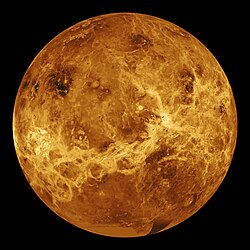Geodynamics of Venus

|
|||||||||||||
| Physical characteristics | |||||||||||||
|---|---|---|---|---|---|---|---|---|---|---|---|---|---|
|
Mean radius
|
|
||||||||||||
|
|||||||||||||
| Volume |
|
||||||||||||
| Mass |
|
||||||||||||
|
Mean density
|
5.243 g/cm3 | ||||||||||||
|
|||||||||||||
|
|||||||||||||
|
Surface pressure
|
92 bar (9.2 MPa) | ||||||||||||
NASA's Magellan spacecraft mission discovered that Venus has a geologically young surface with a relatively uniform age of 500±200 Ma (million years). The age of Venus was revealed by the observation of over 900 impact craters on the surface of the planet. These impact craters are nearly uniformly distributed over the surface of Venus and less than 10% have been modified by plains of volcanism or deformation. These observations indicate that a catastrophic resurfacing event took place on Venus around 500 Ma, and was followed by a dramatic decline in resurfacing rate. The radar images from the Magellan missions revealed that the terrestrial style of plate tectonics is not active on Venus and the surface appears to be immobile at the present time. Despite these surface observations, there are numerous surface features that indicate an actively convecting interior. The Soviet Venera landings revealed that the surface of Venus is essentially basaltic in composition based on geochemical measurements and morphology of volcanic flows. The surface of Venus is dominated by patterns of basaltic volcanism, and by compressional and extensional tectonic deformation, such as the highly deformed tesserae terrain and the pancake like volcano-tectonic features known as coronae. The planet's surface can be broadly characterized by its low lying plains, which cover about 80% of the surface, 'continental' plateaus and volcanic swells. There is also an abundance of small and large shield volcanoes distributed over the planet's surface. Based on its surface features, it appears that Venus is tectonically and convectively alive but has a lithosphere that is static.
The global distribution of impact craters that was discovered by the Magellan mission to Venus has led to numerous theories on Venusian resurfacing. Phillips et al. (1992) developed two conceptual end-member resurfacing models that describe the distribution of impact craters. The first end-member model suggests that a spatially random distribution of craters can be maintained by having short-duration resurfacing events of large spatial area that occur in random locations with long intervening time intervals. A special case of this end-member would be global resurfacing events; for this case one would be unable to tell from the current surface whether the last global event was part of a recurring cycle or a singular event in the planet's history. The other end-member is that resurfacing events that wipe out craters are of small spatial area, randomly distributed and frequently occurring.
...
Wikipedia
